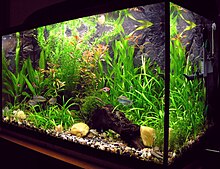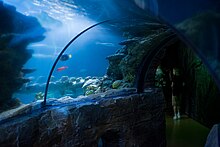
Back Akwarium Afrikaans حوض سمك Arabic Acuariu (recipiente) AST Akvarium Azerbaijani Акварыум Byelorussian Аквариум Bulgarian অ্যাকোয়ারিয়াম Bengali/Bangla Akvarij BS Aquari (recipient) Catalan Akvárium Czech


An aquarium (pl.: aquariums or aquaria) is a vivarium of any size having at least one transparent side in which aquatic plants or animals are kept and displayed. Fishkeepers use aquaria to keep fish, invertebrates, amphibians, aquatic reptiles, such as turtles, and aquatic plants. The term aquarium, coined by English naturalist Philip Henry Gosse, combines the Latin root aqua, meaning 'water', with the suffix -arium, meaning 'a place for relating to'.[1]
The aquarium principle was fully developed in 1850 by the chemist Robert Warington, who explained that plants added to water in a container would give off enough oxygen to support animals, so long as the numbers of animals did not grow too large.[2] The aquarium craze was launched in early Victorian England by Gosse, who created and stocked the first public aquarium at the London Zoo in 1853, and published the first manual, The Aquarium: An Unveiling of the Wonders of the Deep Sea in 1854.[2] Small aquariums are kept in the home by hobbyists. There are large public aquariums in many cities. Public aquariums keep fish and other aquatic animals in large tanks. A large aquarium may have otters,[3] dolphins,[4] sharks,[5] penguins,[6][7] seals,[8] and whales.[9] Many aquarium tanks also have plants.
An aquarist owns fish or maintains an aquarium, typically constructed of glass or high-strength acrylic. Aquaria with flat walls are known as fish tanks or simply tanks, while those with rounded walls are known as fish bowls. Size can range from a small glass bowl, a few liters in volume, to immense public aquaria of thousands of liters. Specialized equipment maintains appropriate water quality and other characteristics suitable for the aquarium's residents.
- ^ "aquarium". Merriam-Webster.com Dictionary. Merriam-Webster. Retrieved 2007-04-03. "Definition of aquarium - Merriam-Webster Online Dictionary". Archived from the original on 2007-04-04. Retrieved 2007-04-03.
- ^ a b Grier, Katherine C. (2008). Pets in America: A History. University of North Carolina Press. p. 53.
- ^ "Sea Otters". Monterey Bay Aquarium. Retrieved 2023-05-01.
- ^ "Dolphins". Clearwater Marine Aquarium. Retrieved 2023-05-01.
- ^ Kaplan, Mike (16 February 2020). "10 Largest Aquariums in the World". Touropia. Retrieved 2023-05-01.
- ^ Baker, Lev (2023-02-28). "Discover 5 Incredible Aquariums and Zoos with Penguins". AZ Animals. Retrieved 2023-05-01.
- ^ "Penguins". www.montereybayaquarium.org. Retrieved 2023-05-01.
- ^ "Pinnipeds in captivity". www.pinnipeds.org. Retrieved 2023-05-01.
- ^ "Marine mammals in captivity". The Humane Society of the United States. Retrieved 2023-05-01.